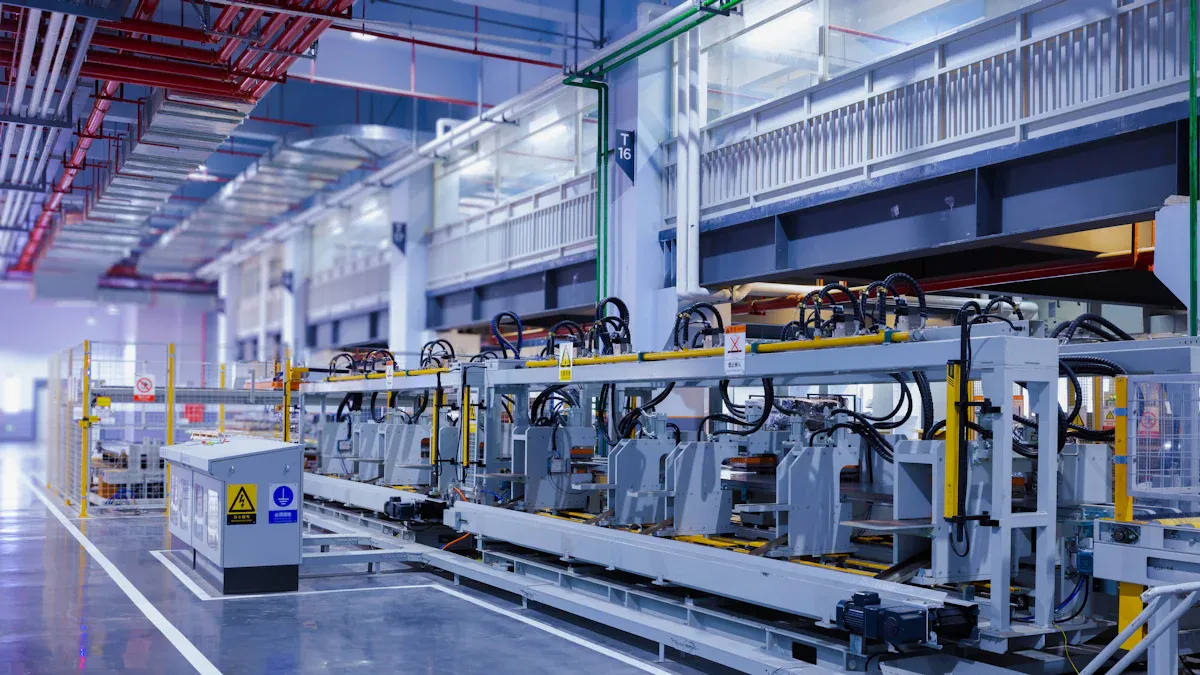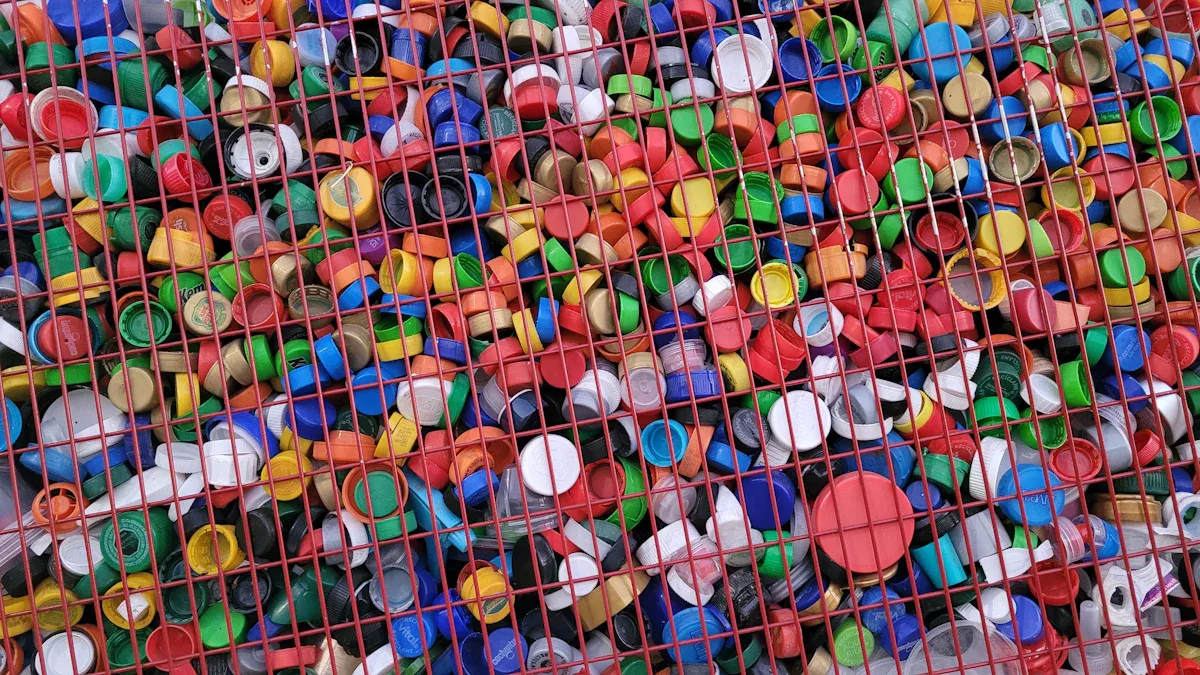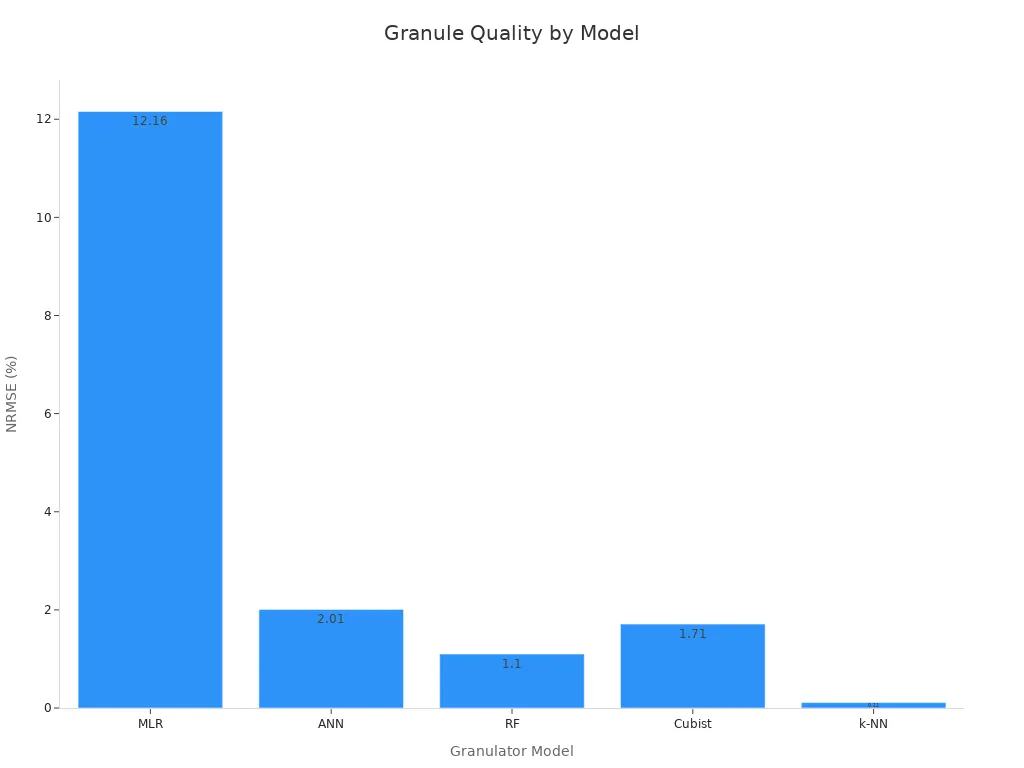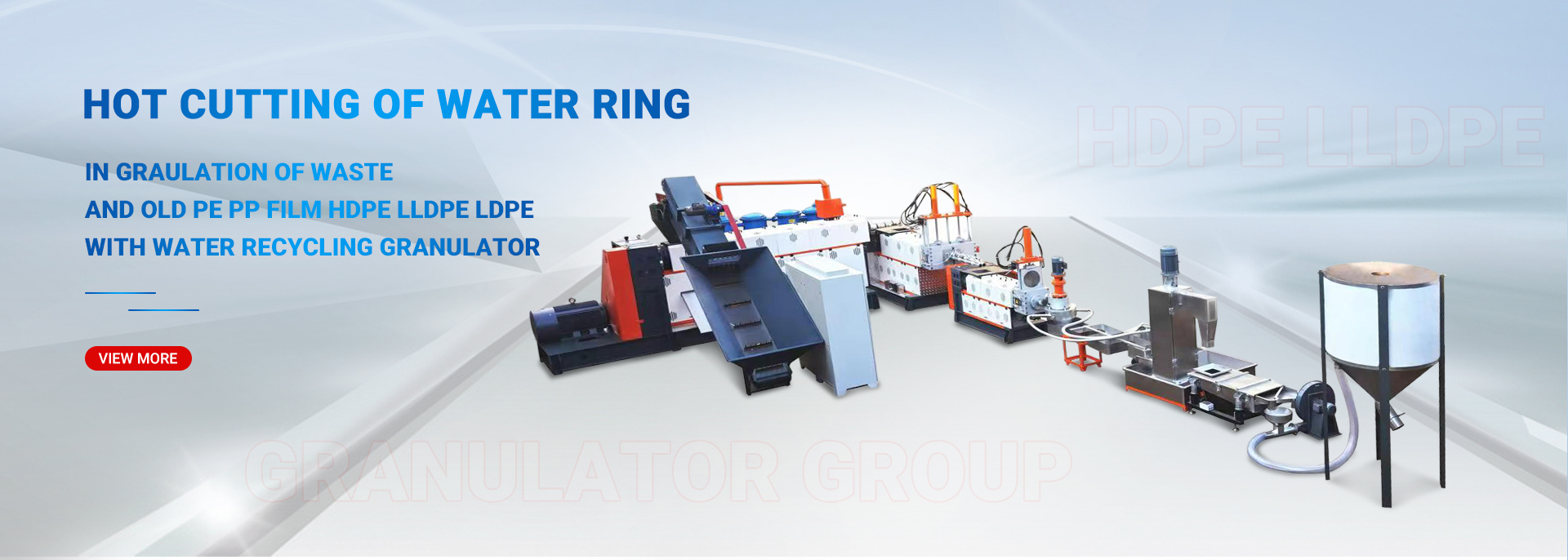
Selecting the right plastic granulator depends on several critical factors. Professionals evaluate machines based on material compatibility, production capacity, granule size, energy efficiency, and ease of maintenance. Other key metrics include operational stability, safety, noise levels, automation options, and user-friendly controls. These criteria help ensure safe, efficient, and cost-effective production.
Key Takeaways
- Choose a plastic granulator that matches your material type, size, and production needs to ensure efficient and safe operation.
- Focus on granule size consistency and production capacity to improve product quality and avoid bottlenecks in your production line.
- Invest in durable machines with energy-efficient motors, easy maintenance, and safety features to reduce costs and boost long-term performance.
Identify Your Plastic Granulator Requirements

Material Type and Characteristics
Selecting the right plastic granulator starts with a clear understanding of the material type and its unique properties. Different plastics—such as rigid, soft, or engineering grades—demand specific machine designs. Material hardness, thickness, and input size influence the choice of cutting mechanism and blade strength. For example, rotary cutters handle rigid plastics efficiently, while scissor-type cutters suit softer materials. Large or bulky plastics often require pre-shredding to prevent machine overload. The design and fabrication process emphasizes matching machine components to the mechanical strength, thermal stability, and chemical resistance of the plastic. Blade arrangement, rotational speed (around 2000 rpm), and screen size must align with the material to achieve efficient granulation.
Tip: Knowing the composition and cleanliness of the plastic waste helps prevent blade damage and ensures consistent output quality.
- Different plastics require tailored granulator designs.
- Hard plastics need stronger blades and more motor power.
- The size of the infeed hopper and crushing chamber should match the largest waste pieces.
- Contaminants like metals can damage the machine, so material cleanliness is critical.
Desired Granule Size and Consistency
Granule size and consistency directly affect downstream processing and product quality. Most production lines target an average particle size of about 300 µm, with a tolerance of ±20 µm. A narrow size distribution, indicated by a span value below 2, ensures uniformity. High-quality granules also meet tensile strength thresholds above 2 MPa, with deformation and elasticity values below 3 MPa. These benchmarks, established through statistical models and design of experiments, enable manufacturers to predict and control granule properties with over 80% accuracy.
Note: Consistent granule size improves material flow, reduces waste, and enhances the efficiency of subsequent manufacturing steps.
Production Volume and Throughput
Production requirements vary widely across industries. Small-scale operations may need a plastic granulator with a capacity of 200-500 kg/h, while large recycling centers often require industrial-grade models capable of 1-5 t/h. Throughput must align with the overall production goals to avoid bottlenecks or underutilization. The following table summarizes key metrics that illustrate the impact of optimal granulator selection on production efficiency:
| Metric | Statistic/Value | Impact on Production Efficiency |
|---|---|---|
| Production Capacity | 200-500 kg/h (small machines) | Suitable for start-ups, ensuring scalable throughput |
| 1-5 t/h (industrial-grade models) | Supports large recycling centers, higher throughput | |
| Energy Consumption Reduction | 25% reduction with variable frequency drive systems | Lowers power costs, improves energy efficiency |
| Screw Life | Up to 8000 hours (3x longer) | Extends operational time, reduces maintenance frequency |
| Downtime Reduction | 50% reduction via automatic screen changers | Enhances continuous operation stability |
| Temperature Control Precision | ±1℃ error margin | Ensures uniform particle quality, prevents material damage |
| Raw Material Waste Reduction | 5% reduction through IoT monitoring | Minimizes waste, improves material utilization |
A well-matched granulator boosts throughput, reduces downtime, and lowers operational costs.
Contamination and Cleanliness
Material contamination poses significant risks to both equipment and product quality. Metals or other foreign objects can damage blades, increase maintenance needs, and cause unexpected downtime. Clean input material extends the life of the plastic granulator and ensures consistent granule quality. Hard plastics with contaminants require machines with reinforced blades and robust rotors. The size of the infeed hopper and crushing chamber should accommodate the largest pieces, while the motor and knife design must support efficient crushing.
Best Practice: Implement regular inspection and cleaning protocols to maintain machine performance and protect against costly repairs.
Compare Plastic Granulator Features and Value

Granulator Types and Cutting Mechanisms
Choosing the right granulator type and cutting mechanism shapes the efficiency and quality of the entire production line. Manufacturers offer several types, including tangential, central, and beside-the-press granulators. Each type suits specific material forms and production scales. Tangential granulators handle bulky or thick-walled plastics, while central granulators process high volumes of scrap. Beside-the-press models fit smaller, continuous operations.
Cutting mechanisms also vary. Open rotor designs excel with light materials, while closed rotors manage heavy, dense plastics. Scissor-cutting action produces smoother granules and reduces dust. Modular designs allow customization of rotors, cutting chambers, and knives, matching the application’s needs.
Proper sizing and configuration prevent inefficiencies such as excessive energy use, poor regrind quality, and downtime. Automated and steady feeding methods, like conveyor or robotic systems, optimize throughput and energy efficiency. Features such as high-amp and high-level alarms help operators avoid motor overload and evacuation problems, reducing risk of damage and costly repairs.
- Modular machine designs improve productivity and reduce waste.
- Soundproofing and evacuation systems lower maintenance costs and create a safer work environment.
- Avoiding mismatched granulator types or improper feeding methods extends machine life and improves operational efficiency.
Motor Power and Energy Efficiency
Motor power directly impacts both throughput and energy consumption. Selecting a motor with the right horsepower ensures the granulator processes material efficiently without overloading or wasting energy. Energy-efficient motors and advanced controls can reduce energy use by 20-30%, depending on the application and motor size.
| Aspect | Numerical Evidence / Description |
|---|---|
| Energy savings from efficient motors | Energy use reduction of 20-30% on granulators by using energy-efficient motors and controls, depending on motor size and application. |
| Motor system improvements | Over 70% of potential motor-system energy savings achievable through system improvements like load reduction, speed control, proper sizing, and maintenance. |
| Starter type impact | Reduced-voltage starters recommended for granulators 50 hp and above to reduce peak power spikes and energy consumption compared to across-the-line starters. |
| Shredder + granulator combination | Using a smaller shredder (40-50 hp) plus a granulator (15-20 hp) can be more energy efficient than a single large granulator (150-200 hp) for thick scrap regrinding. |
Properly sized motors and system improvements not only lower operational costs but also extend equipment lifespan. Automated feeding and load management further optimize energy use, preventing unnecessary wear.
Hopper Size and Feed Opening
The hopper size and feed opening determine the maximum input size and the ease of feeding material into the plastic granulator. A larger hopper accommodates bulky or irregularly shaped scrap, reducing the need for pre-shredding. Wide feed openings prevent jams and allow for continuous operation. For automated lines, hoppers designed for robotic or conveyor feeding maintain steady throughput and minimize manual intervention.
Operators should match hopper dimensions to the largest expected waste pieces. This alignment prevents overfeeding, underfeeding, and associated downtime. High-level alarms and clear sight windows help monitor material flow, ensuring consistent performance.
Screen Size and Granule Output Quality
Screen size plays a critical role in determining the final granule size and its consistency. Smaller screens produce finer granules, while larger screens yield coarser output. The choice of screen size must align with downstream processing requirements.
Quantitative analysis confirms that screen size is one of the most influential parameters affecting mean granule size (d50) in plastic granulator models. Advanced modeling techniques, such as Cubist and artificial neural networks, demonstrate high predictive accuracy for granule size based on screen and process settings.

| Metric / Model | MLR | ANN | RF | Cubist | k-NN |
|---|---|---|---|---|---|
| All data NRMSE (%) | 12.16 | 2.01 | 1.10 | 1.71 | 0.11 |
| All data R² | 0.33 | 0.98 | 0.99 | 0.98 | 0.99 |
These results show that careful selection of screen size, combined with proper compaction force and auger speed, ensures high-quality, uniform granules. Consistent output improves downstream processing and reduces waste.
Noise, Safety, and Automation Features
Modern plastic granulators incorporate noise reduction, safety, and automation features to enhance workplace standards. Polyurethane components, such as gaskets and mounts, reduce noise and vibration, protecting workers from hearing damage and improving comfort. Industrial noise control systems keep exposure below 85 decibels, meeting OSHA regulations and preventing stress-related health issues.
Automation and robotics reduce ergonomic risks by eliminating repetitive manual tasks. Case studies show that safety hazard scores drop significantly after automation, with no reported injuries. IoT and AI integration enable real-time noise monitoring and adaptive control, further improving safety and operational efficiency.
- Noise control systems reduce harmful noise exposure above 85 decibels, preventing hearing loss and stress-related health issues.
- Compliance with regulations such as OSHA’s noise exposure limits (less than 90 decibels for 8 hours) is facilitated by industrial noise control products like acoustic panels and enclosures.
- IoT and AI integration enable real-time noise monitoring and adaptive noise control, improving workplace safety and operational efficiency.
- Growing manufacturing activities increase demand for reliable noise control solutions, which contribute to safer industrial environments.
- Sustainable noise control materials align with corporate ESG goals, enhancing both safety and environmental standards.
Automation features, such as automatic screen changers and connected worker platforms, reduce manual intervention and exposure to hazardous conditions. These advancements support safer, more efficient, and compliant production environments.
Durability, Maintenance, and Blade Quality
Durability and ease of maintenance directly affect the long-term value of a plastic granulator. Machines with robust construction and high-quality blades withstand heavy use and abrasive materials. Modular designs simplify maintenance, allowing quick replacement of worn parts and minimizing downtime.
Regular inspection and cleaning protocols extend machine life and maintain consistent output quality. Features such as easy-access cutting chambers and tool-free blade changes reduce maintenance time. High-quality blades retain sharpness longer, ensuring efficient cutting and reducing energy consumption.
Tip: Investing in durable components and a user-friendly maintenance design pays off through fewer repairs, lower operational costs, and longer machine lifespan.
Total Cost of Ownership and Supplier Support
Total cost of ownership (TCO) goes beyond the initial purchase price. It includes energy, maintenance, downtime, and support expenses. High-quality supplier support plays a crucial role in minimizing TCO.
- Accessible parts and modular design reduce downtime and repair costs, directly impacting total cost of ownership.
- Regular maintenance schedules, supported by supplier guidance, extend machine lifespan and maintain operational efficiency.
- Careful review of warranty conditions and after-sales service responsiveness ensures prompt issue resolution, minimizing unexpected expenses.
- Transparent contracts and responsive customer service build trust and support long-term cost-effectiveness.
- Considering operational expenses such as energy, maintenance, and downtime alongside purchase price provides a comprehensive view of TCO.
- Including contingency costs for unplanned expenses in financial models helps avoid cost overruns.
- Live demonstrations and supplier negotiations ensure equipment meets requirements, reducing risk of costly mismatches.
A real-world example highlights a facility that purchased a granulator with a blower evacuation system. Processing 2,000 pounds per hour, the investment paid for itself in less than 22 days through raw material savings alone. This rapid payback demonstrates the importance of operational efficiency and supplier support in reducing total cost of ownership.
Selecting the right plastic granulator ensures production lines operate efficiently and cost-effectively. Companies often see rapid ROI, with some reclaim systems paying for themselves within a month. Key benefits include:
- Quick ROI by reclaiming valuable scrap, especially with costly color concentrates.
- Proper granulator sizing improves energy efficiency and reduces maintenance costs.
- Modern designs lower downtime and enhance granulate quality.
FAQ
What is the most important factor when choosing a plastic granulator?
Material compatibility stands out as the most critical factor. The granulator must match the type, hardness, and size of the plastic for optimal performance.
How often should operators perform maintenance on a plastic granulator?
Operators should inspect and clean the machine after each shift. Regular blade checks and lubrication extend equipment life and maintain consistent output quality.
Can a single granulator handle multiple types of plastics?
Some granulators process various plastics, but operators achieve the best results by matching machine design and blade type to each specific material.
Post time: Jul-01-2025



